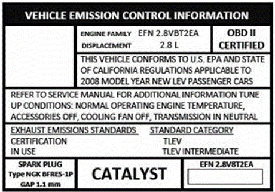CT Low Emissions Vehicle Program (LEV)
Mobile source pollution accounts for a majority of all air pollution emitted in Connecticut and throughout the Northeast. Implementation of the Low Emission Vehicle program helps to meet health-based air pollution standards, achieve significant air quality benefits, reduce people’s exposure to harmful air pollutants from motor vehicle exhaust, and help to bring the best and cleanest new car technology to Connecticut’s consumers.
Why has Connecticut Adopted California’s LEV Program?

The federal Clean Air Act (CAA) requires the federal United States Environmental Protection Agency (EPA) to set nationwide emission standards; however the CAA limits a state’s ability to adopt its own motor vehicle emission standards.
Under the CAA, California is the only state allowed to adopt its own motor vehicle emission standards and the EPA must approve those standards by granting a waiver before California can enforce them. Under section 177 of the CAA, a state may adopt motor vehicle emission standards that are different from federal standards only if those emission standards are identical to California standards.
Connecticut is one of 14 states that has adopted the California emission standards because they are more protective of public health and the environment than federal emission standards.
The Connecticut LEV program consists of:
What are the Low Emission Vehicle Standards?
The LEV program requires that all new vehicles sold in Connecticut meet strict California emission standards. Motor vehicles certified to California emission standards meet more stringent standards for non-methane organic gases (NMOG), hydrocarbons (HC), nitrogen oxides (NOx); carbon monoxide (CO), and particulate matter (PM) and undergo more extensive testing and quality control than vehicles certified to the federal standards.
Some important notes:
- Vehicle manufacturers must deliver new light-duty and medium-duty vehicles for sale into Connecticut that are certified to meet stricter California emissions standards.
- Dealers in Connecticut are required to sell California certified or 50-state compliant vehicles for Connecticut registration.
How Clean is My Vehicle?

The LEV program classifies vehicles according to their emissions along a scale.
- During 100,000 miles of driving, a new 1965 car produced about one ton (2,000 pounds) of smog-forming hydrocarbons.
- LEV II will reduce hydrocarbon emissions, many of which are toxic, from the average new 2010 car to about 10 pounds per 100,000 miles of driving.
- LEV III will further reduce emissions by 73% by 2025 from 2012 emissions levels.
A positive for consumers, the warranty of the pollution control system of the vehicle is extended to 120,000 miles and for some vehicles to 150,000 miles. Since pollution control systems break down over time, extending the warranty will help ensure these vehicles continue to meet emission standards as they get older.
How will you know if a vehicle can be sold in Connecticut?

A Vehicle Emission Control Information Label is applied under the hood of every vehicle.
On this label, you’ll find text indicating that the vehicle conforms to the California regulations. If the vehicle complies with California regulations it can be sold in Connecticut
What types of vehicles does LEV apply to?
The following vehicles are subject to LEV:
- Vehicles with a gross vehicle weight rating (GVWR) of up to 8,500 pounds will be subject to more stringent emission standards.
- Vehicles with a GVWR of 8,501-14,000 pounds will also be held to more stringent emission standards.
- The LEV standards also include tightening of the fleet average standards requiring automakers to reduce fleet emission levels.
Zero Emission Vehicle Standards
The ZEV standard requires manufacturers to deliver advanced technology vehicles to Connecticut yearly to be offered for sale in dealerships. The ZEV program helps to ensure that Connecticut is at the forefront of new vehicle technologies, is beneficial to the state economy and will help to reduce the emissions from mobile sources.

The Department also has other programs designed to help improve the accessibility of advanced technology vehicles to the public like EVConnecticut. EVConnecticut is preparing the state for a rapid and seamless integration of electric vehicles into the market by providing resources, incentives, and information to owners of EVs and by expanding the availability of EV charging stations in Connecticut.
Greenhouse Gas Standard
Mobile sources are also a major source of greenhouse gases and Connecticut is involved in regional and national efforts to reduce greenhouse gas (GHG) emissions. Therefore, Connecticut modified the LEV program to adopt California’s tailpipe greenhouse gas emissions standards beginning with the 2009 model year. In 2010, California worked with EPA and the Auto Manufacturers to unify the federal standards with the California standards and provide Manufacturers with more options when complying with the GHG standards.
The Connecticut Low Emission Vehicle Program, in the final analysis, is about public health and will reduce the exposure to air pollutants of people in Connecticut.
Content last updated February 3, 2020

